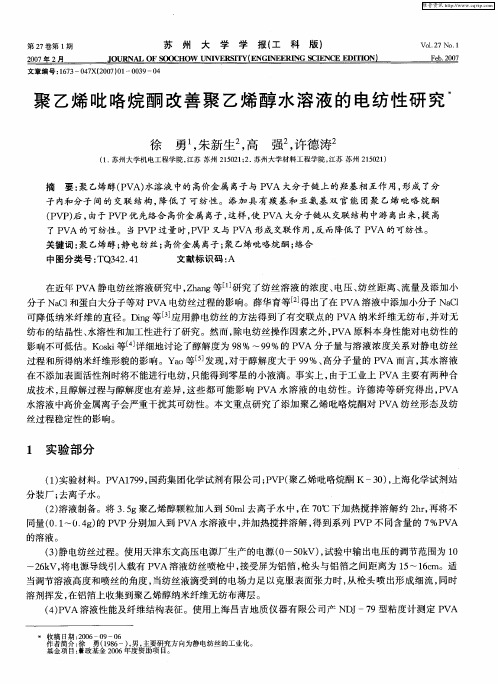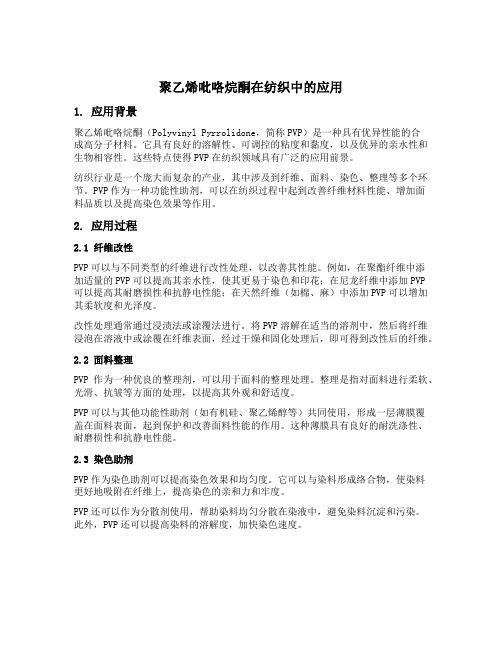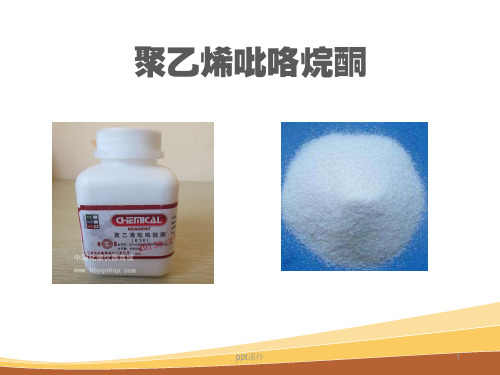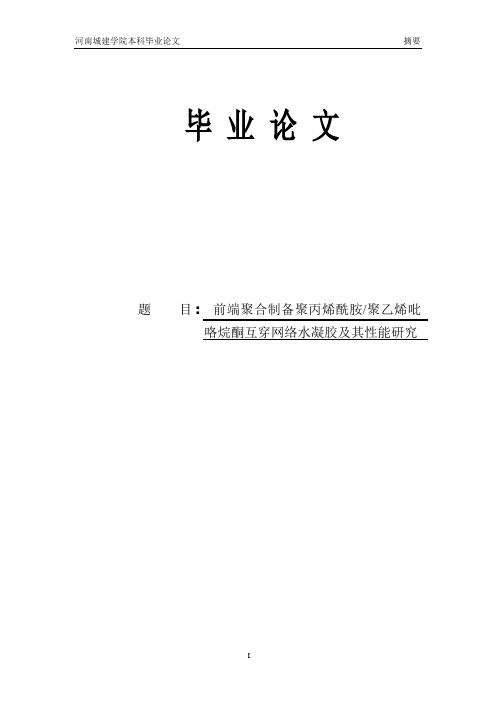聚乙烯吡咯烷酮改性锦丙交织面料的吸湿速干性研究[设计、开题、综述]
聚乙烯基吡咯烷酮改性氰酸酯树脂耐湿热性能研究

( .西 北 工 业 大 学 理 学 院 应 用 化 学 系 , 安 7 0 7 ; .陕 西 科 技 大 学 ,陕 西 咸 阳 7 28 ) 1 西 102 2 10 1 摘 要 :对 聚 乙 烯 基 吡 咯 烷 酮 ( V ) 氰 酸 酯 树 脂 体 系 的 耐 湿 热 性 能 进 行 系 统 研 究 。 选 取 湿 热 老 化 环 境 为 1O / PP / 0h 10C 水 老化 。结 果 表 明 , 着 体 系 中 P P用 量 的 增 大 , 化 改 性 树 脂 的 吸 湿 率 逐 渐 增 大 。湿 热 老 化 使 固 化 树 脂 0 ̄沸 随 V 固
分装 , 使用 前在 5  ̄ 0C真空 烘箱 中干 燥去 水 1 。丙 酮 h 为西 安化 学 试 剂 厂 产 品 , 析 纯 。氯 仿 ( H 1) 分 C C 为
西安 化学 试剂 厂生 产 , 分析 纯 。
12 制 备 固化 树 脂 .
亚胺 树脂 ( MI 等 ; 胶 弹 性 体 天 然 橡 胶 、 丁 橡 B ) 橡 氯
关 键 词 : 乙烯 基 吡 咯 烷 酮 ( V ) 双 酚 A 型 氰 酸 酯 树 脂 ( A C ) 湿 热 性 能 聚 PP; BDy;
中 图 分 类 号 : Q 2 T 33 文献标识码 : A 文 章 编 号 :10 -0 3 0 6 0 -0 2 5 0 555 I 0 )60 7 - 2 0
维普资讯
第2 6卷 第 6期
20 0 6年 1 2月
航
空
材
料
学
报
Vo.2 No 6 1 6, . De e c mbe 2 6 r ooபைடு நூலகம்
聚乙二醇改性锦丙交织面料的吸湿速干性【文献综述】

毕业设计文献综述纺织工程聚乙二醇改性锦/丙交织面料的吸湿速干性一、前言随着人们对服装面料的要求不断提高, 改善合成纤维及面料的功能性和服用性, 已成为纺织界的主要研究方向之一[1]。
纯棉制品以其优良的吸湿透气性带给人们良好的舒适感,但因其抗皱保形性和导湿性差,干燥慢,应用范围受到了限制[2]。
传统化纤则相反,有良好的保形性但吸湿透气性普遍较差。
两者的结合在一定程度上虽可以相互弥补,但效果有限。
人体正常的新陈代谢会产生湿气,此外,户外活动和体育运动会导致人体产生的大量汗水。
服装要具有较强的吸湿与排湿的能力,才能保证服装不会粘贴皮肤而产生冷湿感,才能保证服装与人体肌肤间微环境的干爽与卫生,才能改善人体环境的健康与舒适性。
于是消费者对纤维和面料提出了吸湿排汗功能的要求。
二、锦纶和丙纶纤维及其交织织物简介1、锦纶锦纶是最早进行工业化生产的合成纤维品种,属于脂肪族聚酰胺纤维。
锦纶的主要品种有锦纶6和锦纶66。
锦纶性能好、产量高,用途广,是仅次于涤纶的主要合成纤维品种。
锦纶以长丝为主,另外还有少量的锦纶短纤维。
锦纶长丝主要用于制造强力丝,供生产袜子、内衣、运动衫等。
锦纶短纤维主要是与粘纤、棉、毛及其他合纤混纺,用作服装布料。
锦纶还可在工业上用作轮胎帘子线、降落伞、渔网、绳索、传送带等。
锦纶的主要物理和化学性质:(1)形态: 锦纶的纵面平直光滑,截面呈圆形。
锦纶耐碱不耐酸,在无机酸中,锦纶大分子上的酰胺键会断裂。
(2)强伸性和耐磨性: 锦纶的强度高、伸长较大、弹性优良。
其断裂强度约42~56cN/tex,断裂伸长率达25%~65%。
所以,锦纶的耐磨性特别优良,在常见纺织纤维中居首位。
它是制作耐磨擦制品的理想材料。
但锦纶的初始模量小,易变形,其织物不挺括。
(3)吸湿性和染色性: 锦纶的吸湿性是常见合成纤维中较好的,在一般大气条件下回潮率达4.5%左右。
另外,锦纶的染色性也较好,可用酸性染料、分散性染料及其他染料染色。
表面接枝聚乙烯吡咯烷酮的聚乳酸纤维改性

表面接枝聚乙烯吡咯烷酮的聚乳酸纤维改性张磊;左丹英;易长海;邹汉涛【摘要】针对聚乳酸(PLA)纤维的强疏水性,对聚乳酸纤维表面接枝聚乙烯吡咯烷酮进行研究.通过万能强力仪、红外光谱仪、扫描电子显微镜对改性聚乳酸纤维进行力学性能和结构的表征,并对纤维水解质量减少率、改性纤维吸水率和接枝率进行测定.结果显示:碱水解和酸水解之后的聚乳酸纤维均成功地接枝了聚乙烯吡咯烷酮(PVP);但是碱水解的聚乳酸纤维接枝PVP的接枝率低于酸水解的聚乳酸纤维;2种接枝PVP的聚乳酸纤维吸水率明显提高,分别是未改性聚乳酸纤维吸水率6.44倍和8.97倍,但是接枝后聚乳酸纤维的力学性能均下降.【期刊名称】《纺织学报》【年(卷),期】2015(036)005【总页数】5页(P13-17)【关键词】聚乳酸纤维;亲水性改性;聚乙烯吡咯烷酮;吸水率【作者】张磊;左丹英;易长海;邹汉涛【作者单位】武汉纺织大学材料科学与工程学院,湖北武汉430200;武汉纺织大学材料科学与工程学院,湖北武汉430200;武汉纺织大学材料科学与工程学院,湖北武汉430200;广东均安牛仔服装研究院,广东顺德528329;武汉纺织大学纺织纤维及制品教育部重点实验室,湖北武汉430200【正文语种】中文【中图分类】TS195.6聚乳酸(PLA)纤维是具有来源丰富,可生物降解和加工性能优良等特点。
作为一种脂肪族聚酯纤维,聚乳酸(PLA)纤维亲水性差[1],因此,织物吸湿导湿性差,严重影响其在服装、医疗用品等方面的应用[2-3]。
目前国内外对聚乳酸纤维亲水化改性的方法主要有异形截面纤维的制备、聚乳酸和其他亲水性聚合物的双组分纤维的制备、聚乳酸纤维表面化学改性[4-5]。
1995 年,Woo 等[6]利用六次甲基二异氰酸酯扩链剂,首次对聚乳酸进行扩链反应,并取得成功。
Aslan S 等[7]发现PLA-co-PCL共聚物可作为相容剂促进PCL在PLA基体中的分散;并且随着相容剂的添加,得到的共混薄膜的力学性能良好。
高聚物共混改性聚丙烯纤维的染色性能研究的开题报告

高聚物共混改性聚丙烯纤维的染色性能研究的开题报告一、研究背景和意义聚丙烯纤维是一种重要的合成纤维,具有良好的物理性能、化学稳定性和透气性能等优点,广泛应用于纺织、建材等领域。
但是,由于聚丙烯纤维本身不易染色,所以在实际应用中需要通过添加染料或采用更改纤维表面性质的方法来改善其染色性能。
而高聚物共混是一种常用的改性方法,通过将聚丙烯与适合的高聚物共混,可以改善其染色性能,提高染色效果和染色剂的利用率,因此具有重要的研究意义。
二、研究内容和技术路线本研究旨在探究不同种类、不同比例高聚物共混对聚丙烯纤维染色性能的影响,测试吸水性、染色效果、色牢度等指标,并分析其原因。
具体包括以下研究内容:1. 合成不同种类、不同比例的高聚物材料,并对其结构和性能进行表征。
2. 将高聚物材料与聚丙烯纤维进行共混,采用纺织行业常见的水溶性染料进行染色,测试染色效果及色牢度。
3. 对染色效果、色牢度等指标进行比较分析,探究高聚物共混改性对聚丙烯纤维染色性能的影响机理。
技术路线:1. 物料准备:聚丙烯纤维、高聚物材料、染色剂及辅助剂。
2. 合成高聚物材料:采用化学反应制备不同种类、不同比例的高聚物材料,并进行其结构和性能表征。
3. 处理聚丙烯纤维:将高聚物材料与聚丙烯纤维进行共混,通过热处理、物理方法等改变纤维表面形态和化学性质。
4. 染色:采用纺织行业常见的水溶性染料进行染色,在一定的时间和温度下进行染色,评估染色效果。
5. 测试和分析:测试染色效果及色牢度,分析其影响因素和影响机理。
三、预期研究结果和创新点1. 确定最佳高聚物配方:通过对不同种类、不同比例高聚物共混染色的研究,确定最佳的高聚物配方,提高聚丙烯纤维染色效果和色牢度。
2. 探究高聚物共混改性机理:通过对染色效果、色牢度等指标的测试和分析,探究高聚物共混改性对聚丙烯纤维染色性能的影响机理。
3. 实现对聚丙烯纤维的染色性能提升:通过本研究,实现对聚丙烯纤维染色性能的提升,为其在纺织行业等领域的应用提供技术支持和创新思路。
基于RAFT聚合法的N-乙烯吡咯烷酮均聚物及其嵌段共聚物的合成的开题报告

基于RAFT聚合法的N-乙烯吡咯烷酮均聚物及其嵌段共聚物的合成的开题报告一、研究背景及意义N-乙烯吡咯烷酮(VP)是一种重要的单体化合物,可以通过聚合反应制备各种型式的均聚物及共聚物。
VP均聚物具有良好的热稳定性、抗氧化性和机械性能,能够广泛应用于材料科学、医学、电子工程等领域;VP的共聚物可以使其流动性能和粘度得到明显调节,广泛用于珠片涂料、成膜涂料、泡沫塑料、高分子电解质和细胞支架等领域。
因此,研究N-乙烯吡咯烷酮的合成及其衍生物是目前高分子材料领域的一个热门研究方向。
RAFT(Reversible Addition-Fragmentation Chain Transfer)聚合法是目前实验室中最常用的一种聚合技术。
通过该方法可以得到分子量分布狭窄、链端官能团相同的均聚物及嵌段共聚物,具有良好的结构可控性和定量可控性。
RAFT聚合法在化学、材料、生物等领域得到了广泛应用。
本研究旨在利用RAFT聚合法制备N-乙烯吡咯烷酮均聚物及其嵌段共聚物,探究其结构和性能,并为其在各领域的应用提供理论基础和实验基础。
二、研究内容1.合成不同分子量的N-乙烯吡咯烷酮均聚物通过RAFT聚合法,控制引发剂和单体用量,在合成VP均聚物过程中控制分子量及分子量分布范围。
利用高效液相色谱法(HPLC)和凝胶渗透色谱法(GPC)对合成的VP均聚物进行表征分析,得到其分子量分布范围较窄。
并通过核磁共振氢谱(1H-NMR)和红外光谱(FTIR)对均聚物进行结构表征。
2.合成N-乙烯吡咯烷酮与苯乙烯的嵌段共聚物将VP与苯乙烯(St)用RAFT聚合法共聚,通过改变单体比例和引发剂用量控制共聚物的分子量及组成。
通过GPC、HPLC、1H-NMR和FTIR等技术对VP与St嵌段共聚物的结构进行表征分析。
同时,探究嵌段共聚物的热稳定性、力学性能等性能指标。
3.合成N-乙烯吡咯烷酮与丙烯酸乙酯的嵌段共聚物将VP与丙烯酸乙酯(EA)用RAFT聚合法共聚,通过改变单体比例和引发剂用量控制共聚物的分子量及组成。
聚乙烯吡咯烷酮改善聚乙烯醇水溶液的电纺性研究

中图分 类号 : 3 2 4 TQ 4 .1 文 献标 识码 : A
弱, V P P取代络合作用增强 , 解离出的 P A分子链构象基本呈现无规线 团结构, V 其与水分子结合作用增加 , 表 面活性作用也加强, 故溶液表面张力和粘度下降。由于 P P的极性 明显高于 P A, V V 添加 P P后溶液的电 V 导率增加。但由于 P P与金属离子的络合作用又会降低溶液的电导率 , V 因此 , 液电导率 的变化趋势取决 溶
成技术 , 且醇解过程与醇解度也有差异 , 这些都可能影响 P A水溶液 的电纺性。许德涛等研究得 出, V V PA 水溶液中高价金属离子会严重干扰其可纺性。本文重点研究 了添加聚乙烯 吡咯烷酮对 P A纺丝形态及纺 V
丝过 程稳 定 性 的影 响 。
1 实验部分
() 1实验材料。P A 79 国药集 团化学试剂有限公司 ;V ( V 19 , P P 聚乙烯吡咯烷酮 K一 0 , 3 )上海化学试剂站
文 章 编 号 :6 3 4 X(0 7 0 —0 3 —0 1 7 —0 7 2 0 ) 1 0 9 4
聚 乙烯 吡 咯烷 酮 改 善聚 乙烯 醇 水 溶液 的 电纺 性 研 究
徐 勇 朱新 生2高 , , 强2许德涛2 ,
(. 1 苏州大学机 电工程学 院, 江苏 苏州 2 5 2 ; . 1 0 1 2 苏州大学材料工程学 院, 江苏 苏州 2 5 2 ) 1 0 1
分装 厂 ; 离 子水 。 去 ( ) 液制 备 。将 3 5 乙烯 醇颗 粒加 入 到 5ml 离 子 水 中 , 7" 加 热 搅 拌 溶解 约 2 r再 将 不 2溶 .g聚 0 去 在 0 C下 h, 同量 ( .~04 ) P 0 1 .g 的 VP分别 加入 到 P VA水 溶 液 中 , 并加 热 搅拌 溶 解 , 到 系列 P 得 VP不 同含 量 的 7 VA %P 的溶液 。
改性聚氨酯—聚乙烯吡咯烷酮超分子堵水和防砂性能评价及现场应用

入有 机玻 璃 管 ( . c ×1c , 人 时边 装 边 用有 2 5m 0 m) 填 机玻 璃棒 压 实 , 端分 别 用 出 口孔 径 为 0 5m 的金 两 .c 属 帽封住 , 保证 每 次 实 验 条 件 相 同 。然 后将 玻 璃 管
水平 放置 于 6  ̄ 0C的水 浴锅 内 ; 以流量 为 3 / i mL m n正
将天 然 岩 心 钻 成 直 径 为2 5 m、 为 2 5 m的 .e 长 .c
收 确 H期 2 0 0 8—0 9—1 收 回 }期 2 0 7; ] 0 8—1 0一t 7 f 筋 介 : 志 刚 , , 1 : 工 男 岛缄 『 帅 ,9 3年毕 、 石 油 大学 ( 东 ) 油 工程 々 观 为 中 国石 油 火 学 ( 东 ) 械 设 汁及 论 专 业 在 读 _ 程 18 于 华 采 华 机 f 究 生 , 要 从 事 行 f 开 发 技术 1作 . 系 电 话 :3 6 20 lE—m i w nzg s fci ‘ 研 丰 I l l 一 .联 15 2 60l , al agh@ l .o : o n
结果表 明 , 该体 系在岩 石表 面能 自组装成膜 , 的吸水率低 , 3 膜 在 0~9 ℃ 时, 0 最大水溶胀率小于 4 ; % 堵水 、 防砂效果
好, 出砂率仅 为0 0 L, .3 岩心伤 害率为 2 8 ; . % 矿场实验表 明, 防砂有效周期大于 7个 月, 堵水率大于 3 %。 0
入清水 10 , 0 mL 然后 分别 反 向注 入 1g 约 2倍 孔 隙 5(
( 化学 纯试 剂 ) 石 英 砂 、 利 油 田孤 东 6—3 、 胜 6~4 5 3 井 的地 层 岩心 等 。仪器 包 括 P ip L0型 扫 描 电 hl sX 3 i 子显微 镜 、 电子 天平 和 C Y一1岩 心流 动仪 等 。
吸湿排汗型锦丙交织面料的组织结构设计及性能研究【文献综述】

吸湿排汗型锦丙交织面料的组织结构设计及性能研究【文献综述】毕业设计文献综述纺织工程吸湿排汗型锦/丙交织面料的组织结构设计及性能研究一、前言部分未来衣着用织物将朝舒适、健康的方向发展,以展现经济性、舒适性和功能性的特色,吸湿排汗织物即是其中最重要的项目之一,目前在国内尚在发展中,预期未来将会有很大的成长,并逐渐普及到日常衣物中。
使用吸湿排汗面料可以改善贴身衣物的舒适性,原因是可调节贴身衣物与皮肤表面间的水分及湿度之间的关系(衣服内气候)、衣物和皮肤接触时的压力或接触感等,可称为“可呼吸面料”,面料既具有棉制品的触感,又具清爽感。
在吸湿排汗纤维的运用中,最突出之处是在与运动有关的领域,因此在运动服、竞赛服等已经被大量使用。
运动服领域对该类面料的需求非常的大近年来,随着生活水平的不断提高,人们对服用纤维提出了更高的要求,不再仅限于遮体防寒、实用耐穿,还要求舒适、卫生、美观等各种功能。
纤维材料的吸湿排汗性能就是影响服装穿着舒适性和卫生性的一个重要因素[1]。
吸湿排汗纤维是利用纤维表面微细沟槽所产生的毛细现象使汗水经芯吸、扩散、传输等作用,迅速迁移至织物的表面并发散,从而达到导湿快干的目的[2]。
吸湿排汗型锦/丙交织面料是针对合成纤维织物不易吸湿排汗的缺点 ,国内外纤维及纺织厂商进行了大量的研究而,开发出吸湿排汗型织物。
吸湿排汗面料的发展日新月异,特殊功能性纺织品不断被开发出来,由于其功能优异且价格具竞争力,未来吸湿排汗织物除了用于运动服、休闲服、内衣等衣着用途之外,将朝多用途发展,如鞋材、家具、卫生医疗、防护及农业等领域,市场不断扩张。
二、主题部分1. 吸湿排汗型锦/丙交织面料的组织结构设计及性能研究的背景进入二十一世纪以来,随着我国国民经济的高速发展,我国吸湿排汗面料行业保持了多年高速增长,并随着我国加入WTO。
近年来,吸湿排汗面料行业的出口也形势喜人。
2008年,全球金融危机爆发,我国吸湿排汗面料行业发展也遇到了一些困难,如国内需求下降,出口减少等,吸湿排汗面料行业普遍出现了经营不景气和利润下降的局面。
聚乙烯吡咯烷酮在纺织中的应用

聚乙烯吡咯烷酮在纺织中的应用1. 应用背景聚乙烯吡咯烷酮(Polyvinyl Pyrrolidone,简称PVP)是一种具有优异性能的合成高分子材料。
它具有良好的溶解性、可调控的粘度和黏度,以及优异的亲水性和生物相容性。
这些特点使得PVP在纺织领域具有广泛的应用前景。
纺织行业是一个庞大而复杂的产业,其中涉及到纤维、面料、染色、整理等多个环节。
PVP作为一种功能性助剂,可以在纺织过程中起到改善纤维材料性能、增加面料品质以及提高染色效果等作用。
2. 应用过程2.1 纤维改性PVP可以与不同类型的纤维进行改性处理,以改善其性能。
例如,在聚酯纤维中添加适量的PVP可以提高其亲水性,使其更易于染色和印花;在尼龙纤维中添加PVP可以提高其耐磨损性和抗静电性能;在天然纤维(如棉、麻)中添加PVP可以增加其柔软度和光泽度。
改性处理通常通过浸渍法或涂覆法进行。
将PVP溶解在适当的溶剂中,然后将纤维浸泡在溶液中或涂覆在纤维表面,经过干燥和固化处理后,即可得到改性后的纤维。
2.2 面料整理PVP作为一种优良的整理剂,可以用于面料的整理处理。
整理是指对面料进行柔软、光滑、抗皱等方面的处理,以提高其外观和舒适度。
PVP可以与其他功能性助剂(如有机硅、聚乙烯醇等)共同使用,形成一层薄膜覆盖在面料表面,起到保护和改善面料性能的作用。
这种薄膜具有良好的耐洗涤性、耐磨损性和抗静电性能。
2.3 染色助剂PVP作为染色助剂可以提高染色效果和均匀度。
它可以与染料形成络合物,使染料更好地吸附在纤维上,提高染色的亲和力和牢度。
PVP还可以作为分散剂使用,帮助染料均匀分散在染液中,避免染料沉淀和污染。
此外,PVP还可以提高染料的溶解度,加快染色速度。
3. 应用效果3.1 纤维改性效果通过添加适量的PVP进行纤维改性处理后,可以显著改善纤维材料的性能。
例如,在聚酯纤维中添加PVP可以使其具有更好的亲水性,从而提高染色和印花效果;在尼龙纤维中添加PVP可以增加其耐磨损性和抗静电性能;在天然纤维中添加PVP可以增加其柔软度和光泽度。
聚乙烯吡咯烷酮 ppt课件

ppt课件
14
NHP脱水法(γ-丁内酯法)
卤代法 卤代法是间接脱水法中被研究得较多的方法,用氯化亚砜或盐酸作
卤化剂,与NHP(羟乙基吡咯烷酮)反应生成氯代乙基吡咯烷酮,然后 再进行消除反应而得到NVP
ppt课件
15
NHP脱水法(γ-丁内酯法)
乙酐法
该法是乙酐和NHP在135℃ 、400Pa的低压下分离出中间产物,然后在 460℃下进行热解反应得到NVP
ppt课件
26
5.3 交联聚合
交联聚乙烯吡咯烷酮(PVPP)可以看作是由线型的PVP分子 链通过物理方法或者化学方法相互交联而成的。采用不同合成方 法所得到的PVPP,由于交联方法和交联度不同,PVPP的某些性能也 不相同。根据交联度的不同,PVPP表现为超强吸水性树脂(低交联 度)、吸水凝胶(中等交联度)和不溶物(高交联度)。与PVP相比 较,PVP是一种水溶性高分子,而PVPP则只能在水中溶胀。
3000 47350
2008 年 21300 19800 5000 1500
3500 51100
ppt课件
4
2006-2008年全国内PVP实际产量汇总
国内主要厂家 博爱新开源 杭州南杭 杭州神华 其他厂家
合计
2006 年 1000 1200 400 600 3300
2007 年 1500 1400 400 700 4000
Fikentscher首先发展了NVP的水溶液聚合方法。其反应机理 如下:
ppt课件
23
ppt课件
24
5.1.3 悬浮聚合
GAF公司曾报道一种MVP的悬浮聚合技术。即在庚烷中加入 一种加Gentexv-516的分散剂,使NVP和少量水一起分散呈油滴 状,悬浮于庚烷中,再用AIBN在25℃下引发聚合,可制得平均分 子量高达67万的PVP。
论文:前端聚合制备聚丙烯酰胺聚乙烯吡咯烷酮互穿网络水凝胶及其性能研究

毕业论文题目:前端聚合制备聚丙烯酰胺/聚乙烯吡咯烷酮互穿网络水凝胶及其性能研究摘要聚乙烯吡咯烷酮(PVP) 是一种常见的水凝胶,具有优良的生理惰性、生物相容性和综合性能。
均聚物聚丙烯酰胺水凝胶具有强度低,吸水速率慢,保水性能不好等缺点。
采用聚丙烯酰胺/ 聚乙烯吡咯烷酮互穿水凝胶不仅是解决上述问题的途径之一,而且降低了生产成本,为此近年来许多科学家围绕这一课题展开了大量的研究工作。
本论文通过用MBA做引发剂,APS做交联剂,运用前端聚合制备聚丙烯酰胺(AM)/ 聚乙烯吡咯烷酮(PVP)互穿水凝胶,进而研究配比的不同对水凝胶的性能差异:(1)用红外光谱表征互穿网络水凝胶的结构性能。
(2)当溶剂水的含量及交联剂,引发剂的含量均不变的情况下,调整PVP的含量使其含量从占单体的0%到40%时水凝胶的性能。
随着PVP含量的依次增加,吸水速率从800g/g减到550g/g,吸盐水速率从267g/g减到183g/g.(3)当AM与PVP的含量及交联剂,引发剂的含量均不变的情况下,调整溶剂水的含量,从16ml到20ml 时水凝胶的性能。
随着水含量的依次增加,水凝胶的,吸水率从756g/g减到402g/g,吸盐水速率从252g/g减到134g/g。
(4)当AM与PVP的含量及交联剂,水的含量均不变的情况下,调整引发剂APS的含量,从0.23g到0.27g 时水凝胶的性能。
随着引发剂APS含量的依次增加,吸水速率和吸盐水速率都是先增大后减小.。
(5)将前端聚合与常规聚合方法进行了对比。
关键词:前端聚合丙烯酰胺聚乙烯吡咯烷酮互穿网络AbstractPolyvinylpyrrolidone (PVP) is a common hydrogel, with excellent physical inertia, biocompatibility and overall performance. And acrylamide (AM) low gel strength, swelling ratio is too high. Homopolymer of polyacrylamide hydrogel with low intensity, slow absorption rate, poor water retention and other shortcomings. By polyacrylamide / PVP IPN hydrogels is not only one of the ways to solve these problems, and reduce production costs, for many scientists around the subject in recent years launched a number of studies. MBA to do this study by using the initiator, APS to do cross-linking agent, the use of front-end polymerization of polyacrylamide (AM) / polyvinylpyrrolidone (PVP) IPN hydrogel, then studied the ratio of the different performance of the hydrogel differences:(1) Characterized by IR IPN Hydrogels performance.(2) When the water content of the solvent and crosslinker, initiator levels were unchanged, adjusting the content of its content of PVP monomer from a total of 0% to 40% of the performance of hydrogels. As the PVP content in order of increasing water rates from 800g / g reduced to 550g / g, salt absorption rate from 267g / g reduced to 183g / g.(3) When the AM and PVP content and crosslinker, initiator levels were unchanged, adjusting the solvent content of the water from 16ml to 20ml when the hydrogel properties. With the increase of water content in turn, water gel, water absorption from 756g / g reduced to 402g / g, salt absorption rate from 252g / g reduced to 134g / g.(4) When the AM and PVP content and the crosslinking agent, water levels were unchanged, adjusting the content of initiator APS, from 0.23g to 0.27g when the hydrogel properties. As the initiator APS in order to increase content, water absorption rate and absorption rate are the salt decreases and then increases.(5) wave polymerization and conventional polymerization methods were compared.Keywords: front-end polymerization of acrylamide copolymer PVP IPN目录引言 01 研究背景 (3)1.1水凝胶的结构及相关理论 (3)1.1.1 水凝胶的分类 (3)1.1.2水凝胶的溶胀机理 (5)1.1.3影响吸水性聚合物吸水性能的因素 (6)1.2 高分子材料水凝胶的制备方法及应用 (7)1.2.1 高分子材料水凝胶的制备方法 (7)1.3 对前端聚合进行研究 (8)1.3.1.前端聚合机理 (8)1.3.2.前端聚合的研究意义 (8)1.4 主要研究内容 (8)2 前端制备聚丙烯酰胺/聚乙烯吡咯烷酮互穿水凝胶 (10)2.1 引言 (10)2.2.实验原料与仪器: (11)2.2.1实验所用的主要原料和试剂 (11)2.2.2实验所用的仪器 (11)2.3实验方法 (12)2.3.1聚丙烯酰胺/聚乙烯吡咯烷酮互穿水凝胶的制备方法 (12)2.3.2密度的测定方法 (12)2.3.3吸水率的测定方法 (12)2.3.4吸盐水率的测定方法 (12)2.3.5红外光谱分析 (13)3 研究聚丙烯酰胺/聚乙烯吡咯烷酮互穿水凝胶的性能 (14)3.1 原料的改变量对水凝胶各项实验结果的影响 (14)3.1.1 PVP含量的改变对水凝胶实验结果的影响 (14)3.1.2 溶剂水含量的改变对水凝胶各项实验结果的影响 (14)3.1.3引发剂APS的改变量对水凝胶各项实验结果的影响 (15)3.1.4交联剂MBA量的影响 (16)3.2 互穿网络水凝胶的吸盐(水)性能研究 (17)3.3互穿网络聚合物及单体的红外分析 (18)3.4互穿网络聚合物的强度分析 (19)3.5前端聚合与常规聚合的比较 (20)3.5.1常规聚合制备过程 (20)3.5.2常规聚合与前端聚合制备的水凝胶的吸水性能分析 (20)3.5.3常规聚合制备水凝胶吸盐水性能分析 (21)3.5.4常规聚合与前端聚合制备水凝胶强度性能分析 (21)结论 (23)参考文献 (24)致谢 (26)引言水凝胶是溶胀有大量水分的聚合物网络。
聚乙烯吡咯烷酮(PVP)和脲醛树脂(UF)包覆耐晒黄G的研究

聚乙烯吡咯烷酮(PVP)和脲醛树脂(UF)包覆耐晒黄G的研究李朝辉;湛雪辉;荀育军【摘要】用界面聚合法(以PVP为囊壁)和原位聚合法(以UF为囊壁)制备了耐晒黄G微胶囊.实验结果表明:当以Na2SO4为分离剂,其水溶液加入速度为20 mL/min,囊材含量为15%,分散剂浓度为2.5%时,得到的PVP包覆的耐晒黄G微胶囊性能最好,其平均粒径小于4 μm;而在酸性条件下,以NH4Cl代替有机酸做催化剂,控制酸化时间为4h,反应终点pH为1.5,固化温度为70℃,固化时间为2h时,得到的UF 包覆的耐晒黄G微胶囊性能最好,其平均粒径达3.2 μm.%The light-durable yellow G microcapsules were prepared by interfacial polymerization method and in-situ polymerization processes in this article, using polyvinylpyrrolidone ( PVP) and urea formaldehyde resin (UF) as cyst wall respectively. The experimental results show that the performance of the light-durable yellow G microcapsules cladded by PVP is best and the average particle size of them is smaller than 4 μm under the following parameters; with Na2SO4 as dispersing agent and the dropping speed of its water solution is 20 mL/min, the amount of coating materials is 15% and the concentration of dispersant is 2. 5% ; while the best light-durable yellow G microcapsules cladded by UF, whose average particle sizes is3.2μm, can be attained with the following conditions: with NH4Cl as catalyst instead of organic acid in the acidic condition, acidification reaction time is 4 h, the pH at the reaction end is 1.5, curing temperature is 70 ℃ and curing time is 2 h.【期刊名称】《湖南师范大学自然科学学报》【年(卷),期】2012(035)001【总页数】5页(P56-60)【关键词】界面聚合法;原位聚合法;聚乙烯吡咯烷酮;脲醛树脂;耐晒黄G;微胶囊【作者】李朝辉;湛雪辉;荀育军【作者单位】长沙理工大学化学与生物工程学院,中国长沙410076;长沙理工大学化学与生物工程学院,中国长沙410076;长沙理工大学化学与生物工程学院,中国长沙410076【正文语种】中文【中图分类】O62220世纪70年代开发的微胶囊包覆法可使有机颜料免受环境的影响,改变其性能,延长其发挥功效的时间,现广泛用于纺织、涂料、香料、油墨、塑料、橡胶、医药、化妆品等领域[1-7],近年来还因其具有特殊的应用性能,如光电导性、催化性能等,作为功能性有机颜料应用.与无机颜料相比,有机颜料具有色泽鲜艳,着色强度高、色谱品种繁多、生产过程比较简单,毒性低等特点,随着其应用领域的不断扩大,有机颜料产量大幅度增加,对颜料的各种性能要求也越来越高,需要更好的耐久性、耐冷热性、耐溶性及耐迁移性等.目前有关有机颜料的研究热点是颜料表面改性处理、颜料分散技术等[8-10].本文在研究密胺树脂包覆耐晒黄G性能[11]的基础上,用界面聚合法(以PVP为囊壁)和原位聚合法[12-14](以UF为囊壁)制备了耐晒黄G颜料微胶囊,并对合成条件及胶囊的性能进行了分析测定.1 实验仪器与试剂真空泵(2X-2)、分光光度计(T-722)、激光粒度分析仪(MS-2000)、触点温度计(0~300 ℃)、显微熔点仪(XRC-1)、电子继电器(6402)、扫描电镜(HITACHIS570),差热分析仪(RSZ 2000)和水浴加热装置.聚乙烯吡咯烷酮、硫酸钠、硫酸铵、硫酸镁、硫酸钾、氯化钠、硝酸钠、尿素、甲醛、氢氧化钠、氯化铵、乙酸、柠檬酸、甲酸和丙酮均为化学纯,耐晒黄G为工业级.2 制备原理与方法2.1 制备原理界面聚合法(以PVP为囊壁):用PVP微胶囊化有机颜料是通过引发单凝聚来实现的.在室温或冷却时,通过加入分离剂来引发分离,分离剂可以是具有很好的水亲合力的无机固体或者有机液体.一般是采用非水溶剂或者是无机盐类,使其中一相分离成粘滞液体,并能够沉积在颜料粒子表面,形成包覆的有机膜.有机颜料粒子分散于PVP溶液中,通过沉积来微胶囊化有机颜料.沉积过程所加的聚合物先分散于水中,然后沉积于颜料颗粒上,形成稳定分散的微胶囊粒子.原位聚合法(以UF为囊壁):应用原位聚合法制备微胶囊的缩聚工艺,是由水溶性单体或预聚体,在酸或碱的催化下,分子间脱去小分子,缩聚形成交联网状结构的非水溶性聚合物,沉积到油溶性囊芯表而并包覆形成微胶囊.本实验中尿素氮原子上的活泼H原子很容易跟甲醛反应,生成羟甲基化合物,而羟甲基化合物易脱水形成线性预聚体,其反应式如(1)、(2)所示:CO(NH2)2+2CH2O→CO(NHCH2OH)2(1)nCO(NH2OH)2→CH2NHCONHCH2+(n-1)H2O(2)上述线性预聚体是可溶于水的,在酸和碱的催化作用下能发生缩聚反应,预聚体分子间进一步脱去小分子形成交联立体网状结构的非水溶性缩聚物.2.2 制备方法PVP包覆:在有搅拌的情况下向三口烧瓶中加入一定量的耐晒黄G、分散剂和水,同时在另一容器将一定质量的聚乙烯吡咯烷酮溶解在水中.然后把两溶液混合,搅拌均匀.再在搅拌条件下按一定速率加入17%的无机盐溶液(分离剂),或者是无水丙酮.加完后,经过沉积、过滤、洗涤和干燥,得到PVP包覆的微胶囊化耐晒黄G.UF包覆:取一定量的颜料,加入蒸馏水和适量的分散剂,高速搅拌分散;取30 g 尿素与81 g(HCHO)含量为37%的甲醛(其物质的量之比为n尿素∶n甲醛=1∶2)混合,用NaOH调节pH=8.0,70 ℃下反应1 h得粘稠透明脲-甲醛预聚物,将其与分散液混合,充分搅拌使预聚物溶解于分散介质水中,分批加入催化剂NH4Cl,使介质pH值逐渐减小到3.5左右,加热至70 ℃,继续包覆并逐渐固化,当pH值降至1.5~2.0时加入100 mL热水,保温1 h,用NaOH调节pH=7.0,冷却后离心、干燥,得到UF包覆的颜料微胶囊.3 结果与讨论3.1 PVP包覆耐晒黄G3.1.1 分离剂的选择分离剂是PVP微胶囊化有机颜料的重要试剂.为了确定分离剂盐类的种类和用量,分别采用空白的PVP水溶液进行实验.分别在200 mL质量分数为4%的PVP水溶液中,加入几种质量分数均为17%无机盐,对比其开始沉淀和沉淀完全的用量,其结果如表1所示.表1 分离剂的种类和用量关系样品盐类开始沉积所需用量/mL沉积完全所需用量/mL1Na2SO41251852(NH4)2SO42003303MgSO41002504K2SO451755NaCl没有沉积—6NaNO3没有沉积—从表1可以看出,硫酸根离子引起的沉积效果较好,其原因是硫酸根离子所带的电荷比一价的离子大,对PVP的吸引力大.在不同的试验中可以选用不同的硫酸盐,考虑到操作过程应易于控制和成本等因素,在后续实验中选用用量适中的Na2SO4为分离剂.3.1.2 分离剂添加方式对微胶囊粒径的影响将颜料耐晒黄G分散于水中,同时将PVP分散于另一份水中,然后把两液混合,加入表面活性剂乙醇溶液.在高速搅拌的条件下按不同的方式加入质量分数为17%的硫酸钠溶液.考察添加速度对微胶囊形态的影响,结果如图1所示,按不同的方式加入分离剂,微胶囊粒径有较大的不同,加入速度慢形成的微胶囊粒径小,而且粒径分布比较集中.3种加入方式中以按20 mL/min的速度加入效果最好.这是因为微胶囊在形成的时候,随着分离剂的加入聚乙烯吡咯烷酮沉积在颜料离子表面,如果加入速度过快,沉积的速度也就快,壁材还有可能没有沉积到颜料粒子表面就已经聚集,这样微胶囊包膜就不会很致密,而且有可能有些粒子包膜过厚,而有些粒子却包覆不完全或者没有包覆.所以在试验中采用滴加的方法,速度为20 mL/min.3.1.3 分散剂质量分数对微胶囊粒径的影响对耐晒黄G进行包覆时,分散剂质量分数对微胶囊粒子的平均粒径有较大的影响,根据本课题组对包覆耐晒黄G中对分散剂效果的研究[11],在此选用分散剂3,其加入量对成型微胶囊平均料径的影响结果如图2所示,分散剂质量分数对粒径有很大的影响,随着分散剂质量分数的增加,成型微胶囊的平均粒径逐渐减小,当分散剂质量分数为2.5%时,微胶囊的平均粒径已小于2 μm,再增加分散剂的质量分数,效果不明显,所以选择加入分散剂的质量分数为2.5%.▲——一次加入;●——分3次加入;■——按20 mL/min加入图1 Na2SO4添加速度对微胶囊形态分布的影响图2 分散剂质量分数与微胶囊平均粒径的关系3.1.4 囊材含量对微胶囊粒径的影响囊材含量对微胶囊的粒径的影响主要是由于囊材含量的变化引起芯材/囊材比率的变化,从而导致微胶囊的粒径分布和成囊性能等方面变化,其结果如图3所示.在相同的乳化时间和搅拌速度下,当芯材的用量不变时,随着囊材含量的增加,芯材/囊材的比率随之减小,包覆在芯材上的囊材量也随之增加,从而导致微胶囊的粒径分布范围逐渐扩大,平均粒径也增加.而当囊材的含量小于15%时,成囊性能较差,会产生包覆不完全的现象.因此,选择包覆时囊材的含量为15%.3.2 UF包覆耐晒黄G3.2.1 反应介质pH值的影响本实验中作为囊壁原料的脲-甲醛预聚物是由尿素和甲醛在碱性条件下,经加成反应生成的以二羟甲脲为主的水溶性羟甲基脲.它的分子中存在未反应的游离羟甲基、氨基、亚氨基等活性基团,在酸性条件下,易于进行缩聚反应,首先脱水形成以亚甲基键和少量醚键连接的线型或支链型低相对分子质量物,加热或加入固化剂后分子间交联形成体型网状结构.若在碱性条件下反应,则羟甲基之间不直接反应形成亚甲基键,而是形成二亚甲基醚键,再进一步分解放出甲醛形成亚甲基键,所以碱性介质使缩聚反应时的活性基团活性降低,反应速度相当慢.固化时使交联度下降,影响胶囊壁强度.因此选择在酸性条件下进行缩聚反应.实验表明,终点pH值越低,三维网状结构越趋紧密,形成的微胶囊越坚固,其结果如表2所示,控制终点pH值在1.5~2.0,形成的微胶囊结构紧密、坚固.A——囊材含量15%;■——酸化时间2 h,平均粒径d=11.4 μm B——囊材含量20%;●——酸化时间3 h,平均粒径d=5.3 μm C——囊材含量30% ▲——酸化时间4 h,平均粒径d=3.2 μm 图3 囊材用量与微胶囊粒径的关系图4 酸化时间对粒径及其分布的影响表2 终点pH值对微胶囊结构的影响序号终点pH值微胶囊结构1>4.0表面结构松散,易破裂23.0表面结构松散32.0表面结构紧密41.5表面结构紧密,坚固3.2.2 催化剂的影响缩聚反应阶段常用的酸性催化剂有甲酸、乙酸、柠檬酸等价格低的有机酸.但用有机酸酸化不能使体系的终点pH值小于2.5,会影响微胶囊的结构.若用强酸弱碱盐NH4Cl做催化剂,在缩聚反应中能与水及游离甲醛反应放出强酸使pH值降低,其反应式如 (3)、(4)所示:NH4Cl+H2ONH4OH+HCl(3)4NH4Cl+6HCHO(CH2)6N4+4HCl+6H2O(4)反应时加热有利于NH4Cl分解.氯化铵和有机酸比较,在相同反应条件下更易将体系调至较低pH值,结果见表3.NH4Cl还可以消耗过量的游离甲醛,并在反应中起到固化剂的作用,使囊壁更坚固,反应也比较缓和,容易控制.实验表明,选用价格低廉的工业氯化铵即可满足要求.表3 不同催化剂对终点pH值的影响指标催化剂柠檬酸甲酸乙酸氯化铵缩聚温度/℃70707070缩聚时间/h4~54~54~54~5终点pH值2.5~3.02.52.51.5~2.0 3.2.3 酸化时间的影响用显微镜监测缩聚反应过程,可观察到随着酸性催化剂的加入,pH值降低到5.0以下时囊壁开始形成.若pH值迅速降到2.5以下,则聚合急剧,囊壁形成太快,造成微胶囊粒径分布不匀;同时体系中的粘度增加太快,易结块,微胶囊的质量不易控制.实验发现,适当延长酸化时间,反应终点时pH值就低,得到微胶囊粒径小、粒径分布均匀、微胶囊越坚固,但酸化时间超过4 h后,微胶囊粒径分布基本不变.实验结果如图4所示:将酸性催化剂分批缓慢加入,控制终点pH值在1.5,酸化时间为4 h时,得到平均粒径为3.2 μm的微胶囊.3.2.4 反应温度的影响在其他反应条件相同时,反应温度对微胶囊的粒径影响如图5所示.随着反应温度的增加,形成的微胶囊平均粒径先保持不变,随后急剧上升.这是由于反应温度过高时,缩聚反应太快,导致形成的微胶囊平均粒径迅速增加;而在反应温度较低时,尽管形成的微胶囊粒径和反应温度为70 ℃时的微胶囊粒径相当,但是由于反应温度低时反应速度较慢,反应时间延长,形成的缩聚物相对分子量较小,致使微胶囊固化速度过慢甚至不固化,得到的微胶囊成品量很少,即使调至较低终点pH值,最终也只能得到少量成品微胶囊.而在实验过程中,先在低温下酸化,然后控制温度为70 ℃下反应包覆并逐渐固化,固化时间为2 h,停止反应后离心、干燥可得到球形、分散性良好、成品量较多的固体微胶囊,其电镜照片如图6所示,统计得到微胶囊平均粒径约为3.2 μm.图5 反应温度对微胶囊平均粒径的影响图6 包覆理想的微胶囊表面结构4 结论(1) 用界面聚合法制备了以PVP为囊壁的耐晒黄G颜料微胶囊,优化的包覆条件为:以Na2SO4为分离剂,按20 mL/min的速度加入;囊材含量为15%;分散剂用量为2.5%.可以制得包覆良好,粒径分布均匀且平均粒径小于4 μm的流动性固体微胶囊.(2) 用原位聚合法在酸催化作用下制备了以UF为囊壁的耐晒黄G颜料微胶囊,优化的缩聚反应条件为:以NH4Cl为酸性催化剂,催化剂分批加入,制得的耐晒黄G微胶囊包覆良好,微胶囊紧密坚固,粒径分布均匀且平均粒径达3.2 μm.参考文献:[1] HONG K, PARK S. Melamine resin microcapsules containing fragrant oil synthesis and characterization[J]. Mater Chem Phys, 1999, 58(2): 128-131.[2] 宋健, 刘东志, 张天永. 微胶囊及微胶囊化技术的研究进展[J]. 化工进展,1999(1): 42-44.[3] 徐冬梅, 张可达, 王平, 等. 微胶囊的功能及应用[J]. 精细石油化工, 2003(6): 55-59.[4] 葛艳蕊, 冯薇. 原位聚合法制备玫瑰香精微胶囊的研究[J]. 日用化学工业, 2003, 33(5): 337-339.[5] 郭慧林, 李恒欣, 范辉, 等. 原位聚合法制备红色电子墨水微胶囊[J]. 功能材料, 2006, 37(4): 559-561.[6] PARK B J, LEE J Y, SUNG J H, et al. Microcapsules containing electrophoretic suspension of TiO2 modified with poly(methyl methacrylate)[J]. Curr Appl Phys, 2006, 6(4): 632-635.[7] SIMON B,CHRISTOPHER A,GEOFFRE M.An atomic force microscopy study of weathering of polyester/melamine paim surfaces[J]. Mater Chem Phys, 2001, 42(1-2): 49-58.[8] 蔡涛, 王丹, 宋志祥, 等. 微胶囊的制备技术及其应用[J]. 化工中间体, 2009(12): 6-13.[9] 冀林仙, 史晓滨. 助剂对微胶囊剂稳定性影响研究[J]. 现代农药, 2007, 6(5): 22-23.[10] 邓磊, 林休休, 刘小红, 等. Fe3O4聚脲微胶囊的制备及性能[J]. 苏州大学学报:自然科学版, 2007, 23(3): 70-74.[11] 湛雪辉, 荀育军, 甘均良, 等. 影响密胺树脂包覆耐晒黄G的条件研究[J]. 湖南师范大学自然科学学报, 2007, 30(1): 60-63.[12] 戴杜雁, 张万长, 张婉南, 等. 对原位聚合法制备微胶囊技术的研究[J]. 塑料工业, 1994(2): 27-31.[13] 冀林仙, 石敏先, 郑保忠. 脲醛树脂微胶囊的制备[J]. 材料导报, 2005, 19(5): 109-110.[14] JIMENEZ M, GARCIAH S, BERISTAIN C I. Spray-drying micro encapsulation and oxidative stability of conjugated linoleic acid[J]. Eur Food Res Technol, 2004, 219(6): 588-592.。
N-乙烯基吡咯烷酮型改性聚合物的合成与性质研究

******毕业设计(论文)题目N-乙烯基吡咯烷酮型改性聚合物的合成与性质研究学院化学化工学院专业班级应用化学学生姓名* * 学号**********指导教师* * 职称* *评阅教师职称****年* 月* 日学生毕业设计(论文)原创性声明本人以信誉声明:所呈交的毕业设计(论文)是在导师的指导下进行的设计(研究)工作及取得的成果,设计(论文)中引用他(她)人的文献、数据、图件、资料均已明确标注出,论文中的结论和结果为本人独立完成,不包含他人成果及为获得重庆科技学院或其它教育机构的学位或证书而使用其材料。
与我一同工作的同志对本设计(研究)所做的任何贡献均已在论文中作了明确的说明并表示了谢意。
毕业设计(论文)作者(签字): ****** 年 *月 *日重庆科技学院本科生毕业设计摘要摘要聚丙烯酰胺(PAM)是一种水溶性线性高分子物质,它可以用作采油工程中的减阻驱油剂,聚丙烯酰胺这类产品一般可以用丙烯酰胺的单体通过阳离子,阴离子或自由基引发聚合得到。
N-乙烯基吡咯烷酮(NVP)与丙烯酰胺(AM)的二元共聚物具有良好的抗温和抗盐的性能,对于提高采收率有极好的促进作用,并且其水溶液具有疏水缔合作用。
经过试验的测定,在耐温抗盐以及稳定性的性能上优于聚丙烯酰胺。
本论文主要是针对N-乙烯基吡咯烷酮(NVP)和丙烯酰胺(AM)聚合制备得到NVP-AM二元共聚物,并且使用数显粘度计(型号:LVDV-1 Prime)测定此二元共聚物水溶液的粘度。
实验的制备过程中,对单体的比例,引发剂的浓度以及温度的不同作为实验的变量,来确定该二元共聚物的最佳反应条件,从中选择出最优的一组,然后利用最佳的产品,和在相同条件下制备出来的聚丙烯酰胺(PAM)做老化实验,对比它们的性能优异性。
关键词:N-乙烯基吡咯烷酮丙烯酰胺二元共聚物聚丙烯酰胺驱油剂ABSTACTABSTRACTN - vinylpyrrolidone (NVP) and binary copolymer of acrylamide (AM) has good resistance to moderate salt resistant performance, is good for improving recovery efficiency, and its aqueous solution has hydrophobic association.However, polyacrylamide (PAM) is a kind of water-soluble linear polymer material, it can be used as a drag reduction of production engineering oil displacement agent, polyacrylamide this kind of product can generally with acrylamide monomer by cation, anion or free radical polymerizationThis thesis mainly for N - vinyl pyrrolidone (NVP) and acrylamide (AM) polymerization preparation for NVP - AM binary copolymer, and USES digital display viscometer (model: Prime LVDV - 1) to determine the binary copolymer viscosity of aqueous solution. Experiments of preparation process, the ratio of monomer, initiator concentration and different temperature as the experimental variables, to determine the optimum reaction condition of the binary copolymer, select the optimal group, and then use the best products, and the same conditions in the preparation of polyacrylamide (PAM) aging experiment, comparison of their performance.Keywords: N – vinylpyrrolidone acrylamide binary copolymer polyacrylamide oil displacement agent目录目录摘要 (I)ABSTRACT (II)目录 (III)1文献综述 (1)1.1聚合物驱油剂的概述 (1)1.1.1聚合物驱油剂在油田化学品中的应用 (1)1.1.2油田化学中常用的二元共聚物 (1)1.1.3 NVP-AM二元共聚物与聚丙烯酰胺在油田化学品工业中的应用 (2)1.2聚合物驱油剂的现状 (2)1.3聚合物驱油剂的合成与评定 (4)1.3.1聚合物的反应机理 (5)1.3.2二元共聚物的影响因素 (5)1.3.3聚合物耐盐和抗温稳定性 (6)1.3.4聚合物的热稳定性 (7)2实验部分 (1)2.1聚合物合成实验部分 (1)2.1.1实验仪器与药品 (1)2.1.2聚合物具体合成步骤 (2)2.1.3测定聚合物表观粘度 (2)2.1.4拉曼光谱仪测定聚合物结构 (3)2.2聚丙烯酰胺的合成与测定 (4)2.2.1聚丙烯酰胺的合成 (4)2.2.2聚丙烯酰胺粘度的测定 (4)2.3聚合物性能测定实验 (4)2.3.1聚合物耐高温实验 (4)2.3.2聚合物稳定性评价实验 (5)3 结果与讨论 (6)3.1反应影响因素的结果与讨论 (6)3.1.1聚合物拉曼光谱的研究 (8)3.1.2反应温度对聚合物的影响 (9)3.1.3引发剂浓度对聚合物的影响 (9)3.1.4单体配比对聚合物的影响 (9)3.2小结 (9)3.3聚合物性能测定实验结果与讨论 (10)3.3.1聚合物耐高温的结果与讨论 (12)3.3.2聚合物稳定性评价的结果与讨论 (12)3.4小结 (12)4结论 (14)参考文献 (15)致谢 (17)1文献综述1.1聚合物驱油剂的概述石油是当今时代最重要的能源之一。
聚乙烯吡咯烷酮及其在印染加工中的应用

聚乙烯吡咯烷酮及其在印染加工中的应用李伟勇【期刊名称】《国外丝绸》【年(卷),期】2004(000)004【摘要】随着人们环保意识的加强,国际环境体系标准ISO1400及生态纺织品标准OEKO-Tex Startdard 100的逐步推广,以及发达国家推行的“绿色壁垒”政策,开发环保型的印染助剂已成为当务之急。
近几年来,一些无毒、无害、生物可降解的环保型高分子化合物在纺织印染加工中的应用得到了广泛的研究,聚乙烯吡咯烷酮(PVP)就是由N一乙烯基吡咯烷酮经聚合而成的线性高分子聚合物。
PVP 以其良好的溶解性、高分子表面活性、胶体保护能力、与其它化合物的良好的复配能力,以及对盐、酸及热的稳定性,生物相容性、低毒性、成膜性等优良性能,在印染加工中得到厂泛应用。
PVP不是原发刺激物质、皮肤疲劳物质或致敏物质,对眼睛无刺激性。
因此,PVP是一种安全无毒的“绿色”化学品,可用于环保型印染助剂的开发。
【总页数】3页(P15-17)【作者】李伟勇【作者单位】广东纺织职业技术学院,广东佛山528041【正文语种】中文【中图分类】TS190.2【相关文献】1.聚乙烯聚吡咯烷酮(PVPP)在茶饮料沉淀控制中应用研究进展 [J], 孙庆磊;孔俊豪;陈小强;涂云飞;杨秀芳2.聚乙烯吡咯烷酮成膜剂在种衣剂中的研究与应用 [J], 胡冬松;许勇华;侯建宇;陈杰3.过氧化氢-聚乙烯吡咯烷酮络合物在口腔护理美白产品中的应用 [J], 谢长英;凌峰4.过氧化氢-聚乙烯吡咯烷酮络合物在口腔护理美白产品中的应用 [J], 谢长英;凌峰;5.聚乙烯吡咯烷酮在碘量法测定矿石中铜含量的应用 [J], 刘亚芳因版权原因,仅展示原文概要,查看原文内容请购买。
- 1、下载文档前请自行甄别文档内容的完整性,平台不提供额外的编辑、内容补充、找答案等附加服务。
- 2、"仅部分预览"的文档,不可在线预览部分如存在完整性等问题,可反馈申请退款(可完整预览的文档不适用该条件!)。
- 3、如文档侵犯您的权益,请联系客服反馈,我们会尽快为您处理(人工客服工作时间:9:00-18:30)。
BI YE SHE JI(二零届)聚乙烯吡咯烷酮改性锦/丙交织面料的吸湿速干性研究所在学院专业班级纺织工程学生姓名学号指导教师职称完成日期年月摘要:该课题所研究的是聚乙烯吡咯烷酮改性锦/丙交织面料的吸湿速干性。
研究结果表明经过聚乙烯吡咯烷酮(PVP)整理的织物与未经过整理的原织物相比,织物的蒸发速率、滴水扩散时间明显增快,透湿量、芯吸高度明显增大,刚性、机械性能明显增强。
而含PVP5%的织物与PVP10%的织物相比较,含PVP10%的织物的蒸发速率、滴水扩散时间更快,透湿量、芯吸高度更大,刚性、机械性能明显更强。
因为纤维、纱线之间以及织物中都会有空隙存在,且这些孔隙存在于水(雨水)和水蒸气之间。
根据孔隙自然扩散机理,织物具有转移水蒸气的能力。
因此,经过整理的织物更容易让水分流通,由于PVP的整理,刚柔性增强,机械性能也随之增强。
因此,经过聚乙烯吡咯烷酮(PVP)整理的织物的吸湿速干性能更加强。
关键词:聚乙烯吡咯烷酮,吸湿速干,锦/丙交织面料Study on Moisture Absorbing and Quick Drying Properties of Nylon/Propylene Interwoven Fabric Modified byPoly(N-vinylpyrrolidone)Abstract: The moisture absorbing and quick drying properties of Nylon/Propylene interwoven fabric modified by poly(N-vinylpyrrolidone) (PVP) were investigated in present study. The results showed that the evaporation rate, dripping diffusion time, moisture penetration, core suck height, stiffness and mechanical properties of fabric after modification with PVP increased obviously in comparison with the original fabric. Moreover the evaporation rate, dripping diffusion time, moisture penetration, core suck height, stiffness and mechanical properties of fabric after modification with 10% PVP solution was higher than modification with 10% PVP solution. This because that there are interspaces in fiber, yarn and fabrics. Moreover these interspaces are existed in the water and vapor. Fabrics present the ability for transporting vapor according to the pore diffusion mechanism. As a result, fabrics after modification can transport vapor more easily than original fabrics. The stiffness and mechanical properties of fabrics increased after modification with PVP. It can be concluded that the moisture absorbing and quick drying properties of fabric were improved after modification with PVP.Keywords: Poly(N-vinylpyrrolidone) (PVP); Moisture Absorbing and Quick Drying; Nylon/Polypropylene Interwoven Fabrics目录1绪论 (1)1.1概述 (1)1.2发展背景、现状及趋势 (1)1.2.1 历史背景 (1)1.2.2 国内外发展现状 (1)1.2.3 发展趋势 (2)1.3研究目的及意义 (2)2 实验 (3)2.1材料部分 (3)2.1.1 聚乙烯吡咯烷酮 (3)2.1.2 水性PU (4)2.1.3 锦/丙交织面料 (4)2.1.3.1 锦纶相关介绍 (4)2.1.3.2 丙纶相关介绍 (5)2.2实验部分 (5)2.2.1 织物前处理 (5)2.2.1.1 样品准备 (5)2.2.1.2 工艺流程 (5)2.2.2 蒸发速率 (6)2.2.2.1 蒸发速率和蒸发时间 (6)2.2.2.2 蒸发速率原理 (6)2.2.2.3 蒸发速率的测试方法及步骤 (6)2.2.2.4 实验结果表示 (6)2.2.3 滴水扩散时间 (7)2.2.3.1 滴水扩散时间定义 (7)2.2.4 透湿量 (7)2.2.4.1 透湿量实验仪器及步骤 (7)2.2.5 芯吸高度 (8)2.2.6 刚柔性 (8)2.2.6.1 织物刚柔性原理 (8)2.2.6.2 织物刚柔性的测试原理及步骤 (9)2.2.6.3 实验设备、仪器与试样 (9)2.2.6.4 实验结果 (9)2.2.7 拉伸强度、断裂伸长率、撕裂强度 (9)2.2.7.1 织物的拉伸撕裂强力原理 (9)2.2.7.2 实验设备、仪器与试样 (10)3 实验结果与分析 (11)3.1纤维形态结构 (11)3.1.1 未整理织物纤维的纵、横截面图 (11)3.1.2 整理后织物纤维的纵、横截面 (13)3.1.3 组织结构图 (17)3.2蒸发速率 (17)3.2.1 未经过整理的织物的蒸发速率的分析结果 (17)3.2.2 经过不同含量的PVP整理后的织物蒸发速率的分析结果 (18)3.2.3 蒸发速率结果分析 (19)3.3滴水扩散时间 (20)3.3.1 织物滴水扩散实验结果 (20)3.3.3 滴水扩散实验结果分析 (20)3.4透湿量 (21)3.4.2 织物透湿量实验结果 (21)3.4.3 透湿量实验结果分析 (21)3.5芯吸高度 (22)3.5.3 芯吸高度实验结果分析 (22)3.6刚柔性 (23)3.6.1 织物刚柔性实验结果 (23)3.6.2 刚柔性实验结果分析 (23)3.7拉伸强度、断裂伸长率、撕裂强度 (23)3.7.1织物机械性能实验结果 (23)3.7.3 机械性能实验结果 (27)4. 结论 (28)参考文献 (29)致谢 (30)1绪论1.1 概述随着生活水平的不断提高,人们对服用纤维材料的要求不仅仅是为了遮体、实用、耐穿,还要求款式新颖、美观得体,具有穿着舒适、卫生和便于运动等全面功能。
纤维材料的吸湿排汗性是影响服装穿着舒适性和卫生性的重要因素,特别是对于贴身穿着的衣物更是如此。
合成纤维自问世来凭借其良好的性能应用于人们生产、生活的各个领域。
但由于大多数合成纤维的疏水特性,使其吸湿性差,穿着有闷热感,如何提高合成纤维的吸湿性和透气性是国内外关注的课题[1]。
锦纶面料是我国纺织品的大类品种之一。
随着休闲运动时尚的兴起,锦纶面料的应用领域日趋广泛,大量运用在运动服、休闲服、健美服等多项服饰用品上。
锦纶面料不是因为一时的消费心理在短期内走俏,而是由于它具有良好性能,符合当今世界休闲运动的流行时尚。
近年来,锦纶材质面料的发展日新月异,各种功能性纤维及面料更是层出不穷。
有益于人体健康的功能性纺织品——健康纺织品,包括安全(阻燃、防病毒等),保健(抗菌、抑菌、理疗、护肤美肤、抗紫外等),抗静电、吸湿速干、蓄热调温、自清洁、洗可穿等功能。
各种功能性纺织品的加工都以健康为目的,其加工过程也应具有生态环保性,对人体很安全。
要达到以上要求,必须在纤维制造、纺织加工、染整和服装设计等产业链上进行系统研究,而织物后整理方法在赋予织物功能性方面占有很重要的地位。
由于后整理方法简便易行,在不改变原生产工艺流程以及设备的基础之上,只在后整理工艺中添加相应的功能材料,即可以使织物获得所需要的功能,而且后整理方法容易实现产业化,适宜少批量多品种生产,以满足市场多元化的需求。
1.2发展背景、现状及趋势1.2.1历史背景化学纤维品种的异军突起,出现了许许多多新品种,特别是20世纪90年代,每年登录的化学纤维新产品在800个以上,最近几年每年都有1100个品种以上,所以化学纤维品种成万成几十万个无法说清楚。
化学纤维的排号代表着化学纤维的特性,其排号稍有变化,性能、风格、面貌和用途都有很大不同。
纺织品需具备某些新功能赋于纺织品新的功能在20世纪80年代开始还要求是单项性能的,如远红外辐射吸收性、抗紫外线辐射、抗静电、阻燃、防水、防油污性能等,也就是说只具备其中一项即可。
但20世纪90年代中期以后,尤其是进入新世纪已经呈现出一个非常明确的概念,包括一些性能和功能也并非要求是单项性,而是要求纺织品具有多项功能性要求,如油田工作服,除要求具备抗静电性能之外,还要求具有抗油污性能。
而对一些特殊作用的纺织品也提出了许许多多性能和功能的要求[2]。
1.2.2 国内外发展现状日本、美国先后投入巨资开发具有吸湿排汗功能的相关产品,其开发研究水平处于领先地位。
如日本旭化公司首创的高吸放湿聚氨酯纤维,帝人公司开发的聚酯中空Wellkey纤维,尤尼契卡公司的Hygra纤维,可乐丽公司开发的Sophista纤维,大阪工业技术研究所等单位开发的所谓“挥汗纤维”,吸水、吸汗性聚丙烯腈纤维Colax和Swift以及美国杜邦的Coolmax[3]。
近年来,我国也有一些厂家进行了开发研究。
如我国台湾省中兴纺织的Coolplus、远纺的Topcool、豪杰的TechnofiNe等吸湿排汗纤维,都已有较大的产能,开发了系列的长丝和短纤产品。
广东顺德金纺集团开发了导湿干爽型涤纶长丝Coolnice,江苏盐城化纤集团有限公司开发出的167DT、334DTINY三异型凉爽纤维系列现也已开发出系列长丝产品投放市场。
1.2.3 发展趋势一般化学纤维制成的衣物的透气性、吸湿性都没有天然纤维制成的衣物好,随着时代的进步,人们的服用衣物的质量要求越来越高,而天然纤维的产出已经远远满足不了人们的要求,所以化学纤维慢慢地深入人们的生活中。
